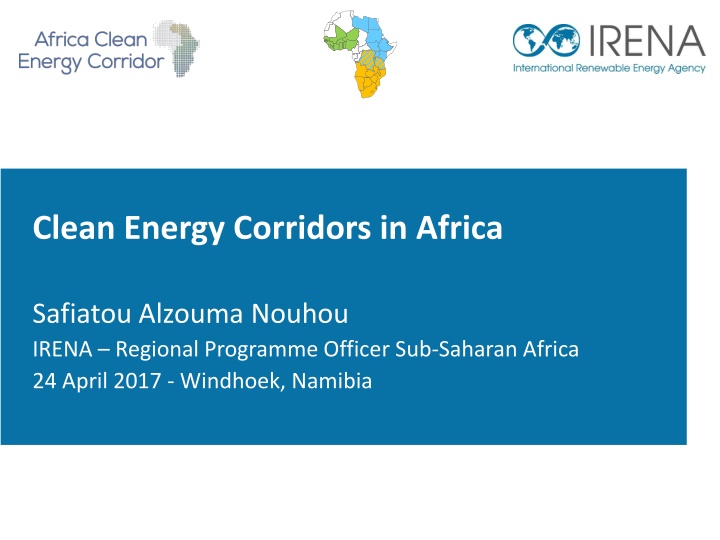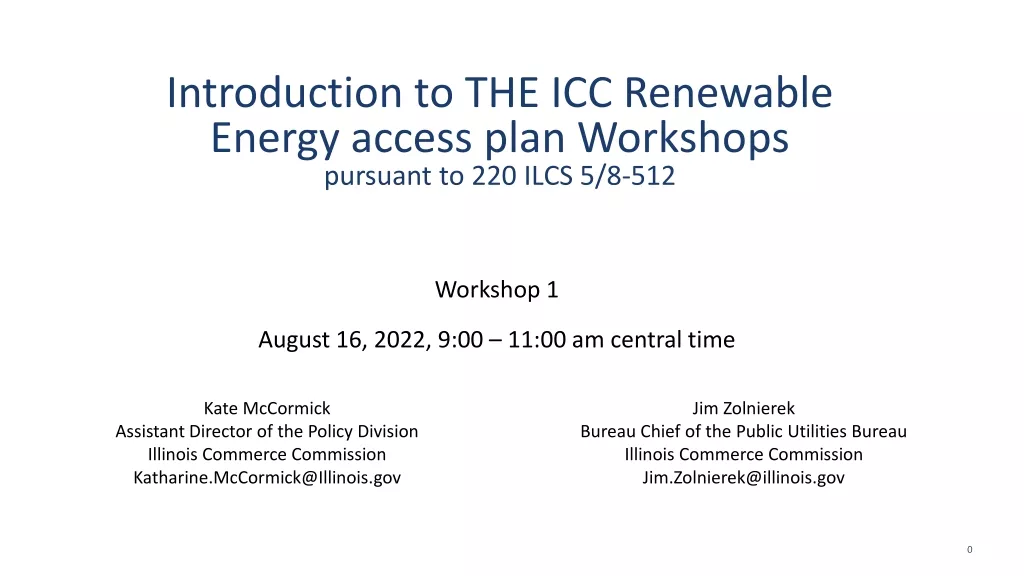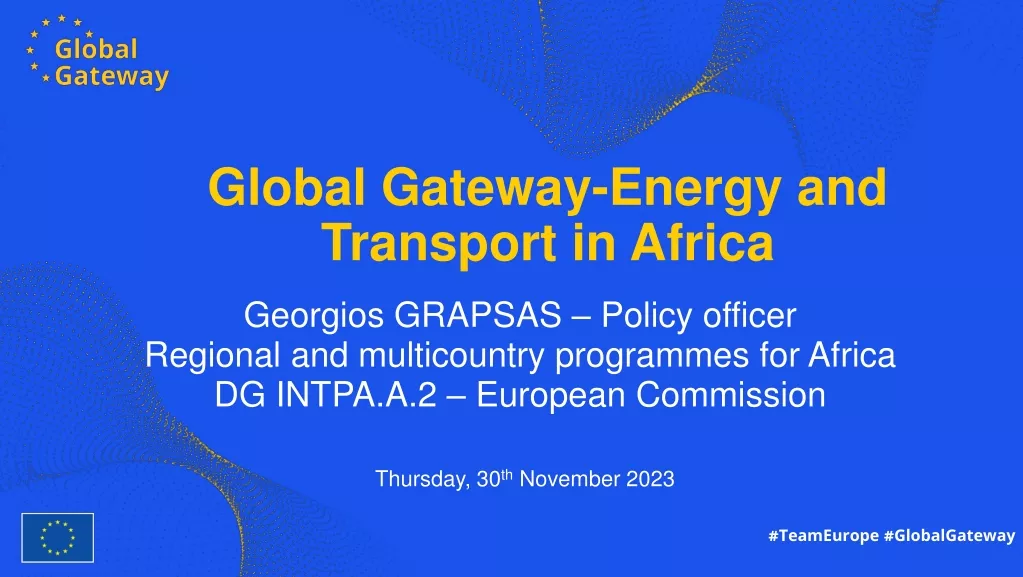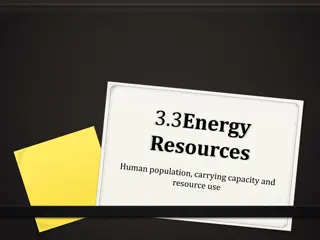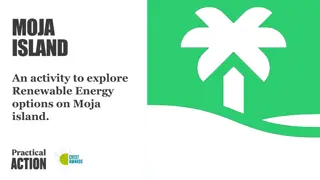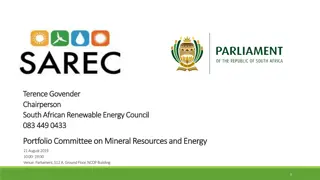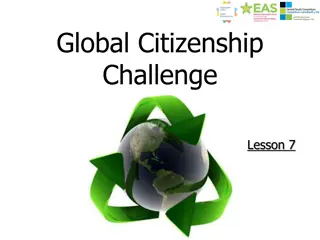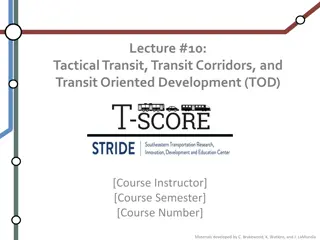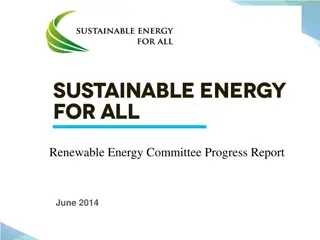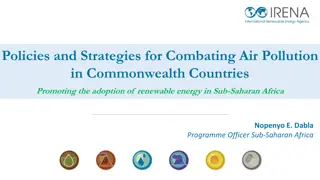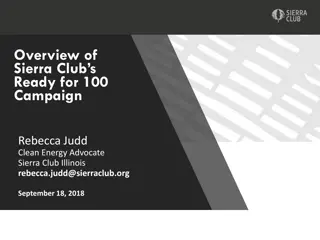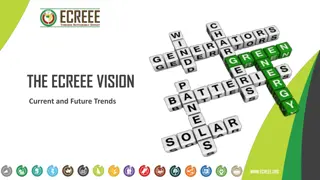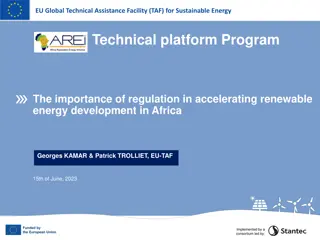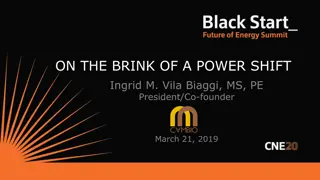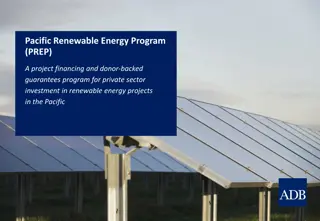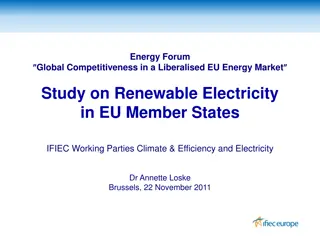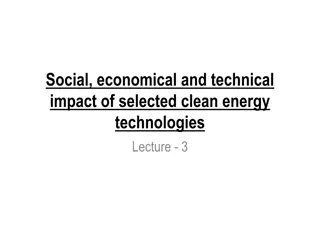Clean Energy Corridors in Africa: Promoting Renewable Power Integration
Clean Energy Corridors in Africa aim to develop renewable energy resources, integrate renewable power into grids, promote cross-border trade, and build on regional initiatives like EAPP, SAPP, ACEC, WAPP, and WACEC. The concept focuses on resource assessment and zoning, country & regional planning, enabling investment frameworks, capacity building, and creating awareness for political support. Activities like zoning exercises, identification of suitable zones for solar & wind projects, and scoping assessments have been completed to facilitate the implementation of the ACEC pillars.
Download Presentation

Please find below an Image/Link to download the presentation.
The content on the website is provided AS IS for your information and personal use only. It may not be sold, licensed, or shared on other websites without obtaining consent from the author.If you encounter any issues during the download, it is possible that the publisher has removed the file from their server.
You are allowed to download the files provided on this website for personal or commercial use, subject to the condition that they are used lawfully. All files are the property of their respective owners.
The content on the website is provided AS IS for your information and personal use only. It may not be sold, licensed, or shared on other websites without obtaining consent from the author.
E N D
Presentation Transcript
Clean Energy Corridors in Africa Safiatou Alzouma Nouhou IRENA Regional Programme Officer Sub-Saharan Africa 24 April 2017 - Windhoek, Namibia
IRENA Regional Initiatives IRENA Regional Initiatives
Rationale of the Clean Energy Corridor Concept Rationale of the Clean Energy Corridor Concept Africa Clean Energy Corridor Energy Security Competitive prices and economies of scale Greening the ASEAN Power Grid Central America Clean Energy Corridor Regional markets Job creation West Africa Clean Energy Corridor Reduction of environmental impacts
Clean Energy Corridors in Africa Clean Energy Corridors in Africa Develop RE resources and integrate Develop RE resources and integrate renewable power into grid renewable power into grid Promote cross Promote cross- -border trade of border trade of renewable power renewable power Build on regional initiatives Build on regional initiatives Eastern Africa Power Pool (EAPP) Southern Africa Power Pool (SAPP) Africa Clean Energy Corridor (ACEC) West Africa Power Pool (WAPP) West Africa Clean Energy Corridor (WACEC)
ACEC Implementation Pillars Resource Assessment and Zoning Resource Assessment and Zoning Country and Regional Planning Country and Regional Planning Enabling Frameworks for Investment Enabling Frameworks for Investment Capacity Building Capacity Building Awareness Awareness- -raising and Political Support raising and Political Support
Resource Assessment and Zoning Resource Assessment and Zoning Activities Completed Activities Completed ACEC: Zoning exercise for Wind, Solar PV and CSP for all the 21 countries to determine the most feasible and cost effective RE zones WACEC: Identification of suitable zones for solar and wind energy projects at 1-km resolution (solar, wind) for on-grid and off-grid WACEC: Scoping assessment for the solar component completed by EU-TAF
Resource Assessment and Zoning Resource Assessment and Zoning Outcomes & Impacts Outcomes & Impacts Zoning work outcomes being used both at national and regional levels: - In Swaziland for the updating of the energy master plan - In Zimbabwe in the development of the renewable energy policy and as basis for the development of tenders - Resource Assessment training for solar and wind in Djibouti
Resource Assessment and Zoning Resource Assessment and Zoning Upcoming Activity Upcoming Activity Analysis of selected sites in both ACEC and WACEC Due diligence process for selected sites within the identified RE zones to develop: a renewable power Generation Model, using high resolution time series data a Financial Model, including cash flow projections and IRR for the site This will help (i) decision makers in designing RE procurement process (ii) investors in assessing financial viability of the project
National & Regional Planning National & Regional Planning Objective Based on the results of the zoning exercise, development and implementation of least-cost System Planning Test models to support planning for long-term power generation expansion plans. Outcomes & Impacts Outcomes & Impacts SPLAT model tools SPLAT model tools developed and available; five regional training seminars held, with 140 African energy planners taking part Implementing SPLAT in updating of the Swaziland Swaziland energy master plan, to be completed by mid-2017 (can be implemented in other ACEC countries) Integrate the zoning results into the regional master plans Integrate zoning results to identify projects of high regional importance to be regional master plans included in the revision of PIDA
Enabling frameworks for Investment Enabling frameworks for Investment RRA Impact Completed for Djibouti, the Gambia, Ghana, Niger, Senegal, Swaziland, Mozambique, Tanzania, Completed for Djibouti, the Gambia, Ghana, Niger, Senegal, Swaziland, Mozambique, Tanzania, Zambia; In progress for Egypt, Mali and Zimbabwe Zambia; In progress for Egypt, Mali and Zimbabwe They have triggered tangible changes in policies, legislations and institutional setups They have triggered tangible changes in policies, legislations and institutional setups DJIBOUTI MOZAMBIQUE RRA used as basis for a geothermal intervention of USAID Inclusion of RE in the electricity Master Plan and Electricity Law Tax exemption for all RE equipment Developed national strategy for energy conservation focusing on renewables. RE feed-in-tariffs adopted Rural Electrification approach revised to create room for more private sector involvement SWAZILAND NIGER Grid Code adopted RE and IPP policies under development RE being integrated into national energy policy and legislation Integrated resource planning under development Creation of a new Rural Electrification Agency Reallocation of part of the tax on electricity for rural electrification as part of the internal resource mobilization mechanism for RE promotion
Enabling frameworks for Investment Enabling frameworks for Investment Regulatory Support Objective Objective To support RERA and national regulators in the development, management and implementation of planning processes for the power systems operating with higher shares of renewables Outcomes Outcomes Global best practices for utility Integrated Resource Plans in SAPP developed and results to be presented in 2017 Best practices implemented in two pilot countries Namibia and Zimbabwe Regulatory training: First Africa Renewable Energy Training Week -
Enabling frameworks for Investment Enabling frameworks for Investment Technical Assistance and Capacity Building: Post-RRA or Per Request 1-4 December 2015 - Mbabane, Swaziland 17-21 July 2016 Djibouti, Djibouti 11-14 April 2016 Mbabane, Swaziland 18-19 April 2016 Windhoek, Namibia 27 June 08 July 2016 Mbabane, Swaziland 27-29 September 2016 Pretoria, South Africa 21-23 November 2016 Maputo, Mozambique 17 October 28 October 2016 Mbabane, Swaziland 21 November 25 November 2016, Mbabane, Swaziland Zambia Kenya Southern Africa Renewable Energy Statistics Workshop 3rd & 4th training courses of MESSAGE Regulatory environment that support the 1st training course of MESSAGE and SPLAT-SW 2nd training course of MESSAGE and SPLAT-SW Renewable Power Development in Southern African Power Systems: First Stakeholder Workshop Training on Resource Assessment and Project Development Workshop for South Renewable Energy Data Collection and Processing and SPLAT-SW development and deployment of RE both on- grid and off-grid Mozambique Renewable Energy Investment Workshop FIT to Auctions Technical support for transition from Technical support for a Policy, Strategy and Africa
ACEC Project Support ACEC/WACEC
Partnerships Partnerships
Noteworthy Challenges Noteworthy Challenges Insufficient coordination among stakeholders at national level No structured coordination among development partners Absence of dedicated RE regional counterparts in the Eastern African region to coordinate work under different pillars Low capacity in countries to take the work forward; information and capacity acquired not disseminated
Recommendations Recommendations 1. Ensure coordination among various sectors and actors for a smooth implementation of the Clean Energy Corridors (ACEC/WACEC) 2. Ensure continuing strong commitment at country level as well as the ownership of the Clean Energy Corridors 3. Embed the clean energy corridors in national renewable energy and climate change agendas as well as the process of creation of a sustainable and low-carbon power market 4. Given the fact that the Clean Energy Corridors build on PIDA, ensure that all the projects of regional importance coming out of ACEC/WACEC are considered to be part of the revised version of PIDA
